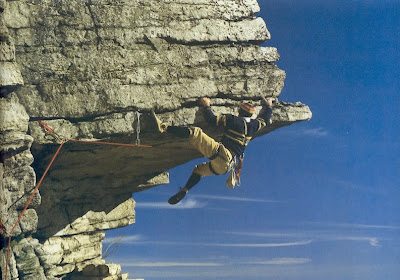 |
| A rock climber marvels at the undulating thin cracks on Devils Tower ... how convenient! |
Climbers know the rock they climb on intimately. They know the basic types -- sandstone, limestone, granite. They are experts on the nature of the rock surface, whether it is smooth or has features -- tiny crimper edges, big buckets, knobs, pockets, slopers, jugs. They are acutely aware of the angle of the rock face and its height. They know the nature of the fractures -- narrow vs. wide, undulating vs. parallel -- critical for hand and foot holds and gear placement. They worry about the competence of the rock; might those hand holds or even an anchor bolt pull out? Climbers clearly are a ready audience for stories about the geology of their playgrounds.
 |
| “Why are there so many offwidths at Vedauwoo?” Jason Haas wonders, as he makes his way up Main Street (5.10a). |
Many climbing guidebooks include something about the geology of the area, but these explanations typically are brief, sometimes just the rock type and its age. Fortunately there is an alternative. Flakes, Jugs, and Splitters: A Rock Climber's Guide to Geology, by geologist/climber Sarah Garlick, covers 50 climbing areas in North America as well as some in Africa, Asia, Australia, Antarctica, South America and Europe. This is an ambitious project! Climbing areas vary widely in rock type and geologic history, and most include at least one geologic mystery. A lengthy paper could be written on each I’m sure.
The book begins with “Geology 101” -- introductory material including geologic time, rock classification and formation (even the tricky classification of granites), plate tectonics, uplift, and weathering/erosion. The main part of the book is organized by climbing area within geographic regions. It would be impossible to provide comprehensive explanations for each, and so Garlick focuses instead on specific geologic features, for example the steepness of New River Gorge in West Virginia, the high elevations of the Rockies in Colorado, the parallel-sided splitter cracks of Indian Creek in Utah, and the cavernous hollowed-out huecos of Hueco Tanks in Texas. Each section starts with a question: “Why are there big walls in Zion?”, “What are all those chicken heads at Cochise Stronghold?”, “Why isn’t there rock climbing in Florida?”
Though organized by area and focused on specific features, the book includes more than just local geology. Garlick does a good job of describing the bigger picture. For me, the explanations of plate movements, collisions, rifts, jostling and passive margins and how they relate to climbing areas are the most interesting parts of the book. For example, we can’t explain the Gunks in New York without invoking 1) mountain-building 450 million years ago when a chain of islands collided with the eastern margin of North America, resulting in erosion and deposition of sediments that would become the hard conglomerate we climb on; and 2) tectonic compression 300 to 250 million years ago during the formation of Pangaea that tilted the strata and produced those bomber holds, making some of the big Gunks roofs surprisingly easy to climb. Thank you plate tectonics.
 |
| Bigggg roof but only 5.8. Photo by Mike Freeman, from Dick DuMais' Shawangunk Rock Climbing, 1985. Posted at SuperTopo. |
A well-illustrated brief overview of the history of the Appalachian Mountains is presented in a three-page “sidebar”, providing the context for many of the climbing areas in the eastern US. A similar approach is used for the Rockies (“A Short History of Colorado”). Other shorter sidebars explain diverse topics such as the multitude of granite plutons in California, the Ancestral Rockies and the mysterious Gunks quartz. There are ample illustrations of geologic phenomena and processes throughout: plate tectonics, uplifts and basins, stratigraphic columns, salt anticlines, metamorphic core complexes, ancient landscapes and many more. And of course there are spectacular photographs of crags and climbers. This is a book worth perusing from cover to cover, in addition to studying one’s favorite crags -- perhaps a good diversion for rainy days.
 |
| Excerpt from "A Short History of Colorado"; click to view. |
Given the number and diversity of rock climbing areas, this kind of book can provide only a quick look at a selection of crags. For example, discussion of Devils Tower includes just one of the theories behind this puzzling rock, but that’s understandable -- it has proven to have a history mysterious enough to support multiple possible explanations. Less than a page is devoted to Yosemite Valley, in spite of its important place in the history of climbing (but see also the granite of the Sierra Nevada). The Adirondacks are omitted entirely. Even so, I think Garlick has made good choices about what to include; the result is a collection of interesting wide-ranging stories about the diverse materials and histories of the mountains and rocks we climb.
If you are a geologically-challenged climber, this book will make a bit of a geologist out of you and I bet you will enjoy it, even though sections may prove to be somewhat technical (a glossary would have helped). If you are a geologist that climbs, the book provides introductory material as well as references for further research. I am an amateur geologist and casual climber -- for me, it was a great read and will be a good reference in the future.
Flakes, Jugs, and Splitters: A Rock Climber's Guide to Geology by Sarah Garlick. 2009. FalconGuides. Paperback, 224 pages, ISBN 0762748370. $13.59 from Amazon
F, J, & S won Best Book in the Mountain Exposition category at the 2009 Banff Mountain Film Festival.
Other reviews can be found at:
The climber website summitpost.org


No comments:
Post a Comment